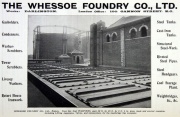Whessoe Foundry Company Ltd at Foundry Street, Hopetown, Darlington
c.1790 Foundry established at Darlington[1].
1832 W. and A. Kitching opened the Hope Town Foundry.
A large part of the work of the firm in the early days was the manufacture of locomotives; the Works was responsible for many of the earliest locomotive including Derwent No.25[2] which was later placed on a pedestal at Darlington station, and then in Darlington Rail Museum. Derwent 25 was built by A. Kitching, founder of Whessoe Foundry (see photo of plaque).
The works were operated as C. l'Anson and Co of Hope Town Foundry which was later known as Whessoe Foundry.
1860 The Hope Town works were sold to the Stockton and Darlington Railway to enable them to extend their own works. Part of the general engineering work was transferred to the Whessoe Foundry Co at Darlington with much of the best machinery.
1860 General engineering work transferred from W. and A. Kitching with much of the best machinery from Hope Town Foundry.
c.1864 Charles I'Anson and Alderman Kitching established the engineering and iron-founding business of Charles l'Anson & Co. For many years this firm was mainly engaged in the production of all types of railway plant — waggons, signal work, bridgework, and iron founding generally.
Charles' son, James I'Anson, became a partner - presumably this was when the firm became Charles l'Anson, Son, & Co
1875-81 Produced five locomotives, possibly by Charles I'Anson and Son. Thomas Hudson was responsible for these engines, who was originally with John Harris at the Albert Hill Foundry in Darlington[3]
Possibly one locomotive was produced by A. E. and H. Kitching.
1881 Took limited liability company status[4] as Whessoe Foundry Co.
1881 A railway engine was built for William Boby and Son
1914 Directory: Listed as Mechanical Engineers
Mainly making gas plant, including gas holders, tanks, chemical plant, mining machinery, turntables and weighing machines. Bulk oil storage built for H. M. Admiralty, Shell Marketing Co, and many other companies. Cast iron linings for Bakerloo, Central and other tube lines and the Post Office railway.
1920 Public company Whessoe Foundry and Engineering Co formed to acquire the business and assets of the Whessoe Foundry Co[5].
See Whessoe Foundry and Engineering Co
See Also
Sources of Information
- The Engineer of 29th October 1920 p448
- Kelly's Directory of Durham, 1914 p661







